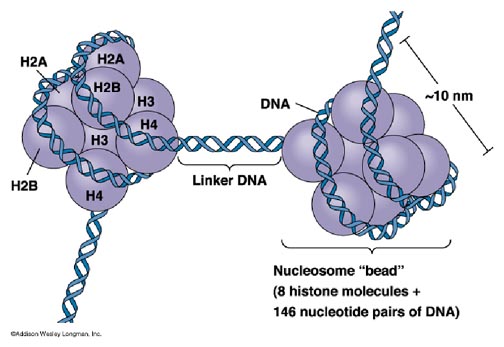Daily Newsletter March 19, 2012
Video Special: In honor of St. Patrick's Day, here is a little biology video for you. Can you identify and describe all of the processes the signer is describing?
Today's Topic: Chromosomes
Before we discuss DNA and cell division, let's talk a little about chromosomes. A chromosome is a single molecule of DNA with associated packaging proteins, and is visible only during Metaphase and Anaphase of nuclear division.
We use the term chromosome to refer to a single molecule of DNA, but remember, in the strict sense, it only refers to a visible arrangement of DNA and proteins seen during nuclear division.
Another loose use is referring to the single, circular DNA molecule found in bacteria (or other prokaryotic DNA). As bacterial DNA is not held by the same packaging proteins, and has different packaging issues, the use of chromosome in this case is in error. The term genophore is a more appropriate term.
In eukaryotes, DNA must be packaged. One reason for this is to prevent physical strain or damage to the DNA molecule. The second reason is to conserve space. DNA is just too large when it is not packaged. The basic unit of DNA packaging is nucleosome. The nucleosome is a unit of packaged DNA, in which the DNA molecule is wrapped 1.67 times (~147 base pairs) around a core of 8 positively charged histone molecules (positive charge attracts negative phosphates).
These histone cores, when associated with Histone1 can begin to supercoil into a fiber. A cascade of interactions causes more supercoiling which ultimately forms the chromosome.
The chromosome when it first forms during prophase of nuclear division is actually two freshly replicated molecules of DNA (we just copied DNA). Below is a picture of an individual chromosome:
Notice that the two sides of the Chromosome are individual DNA molecules that we refer to as Chromatids. Holding the two chromatids together is a protein rich region known as the centromere. At the centromere, we will find a molecular motor known as the kinetochore. We will see the operation of the kinetochore during cell division.
Here is a video to help you visualize the process:
Daily Challenge:
In your own words, describe how DNA is packaged into a chromosome. Why is it important that we package DNA at the nucleosome and chromosome level?
Other resources:
Administrative Note: Milestone Paper 2
You have until tomorrow night (March 20th) to finish the review process.



I've notice a number of people coming to this page, and I'm a little curious. Take a moment and tell me why you stopped by this page.
ReplyDeleteit is very nice to see how chromosomes are formed thanks
ReplyDeleteThank you. I'm glad it helped.
ReplyDelete